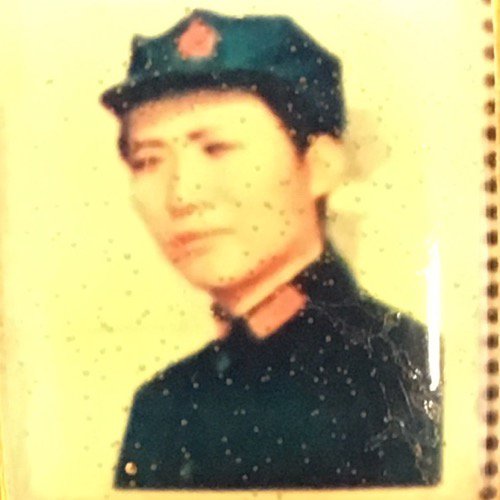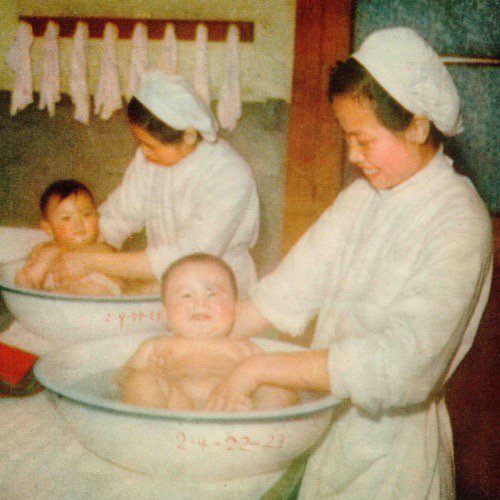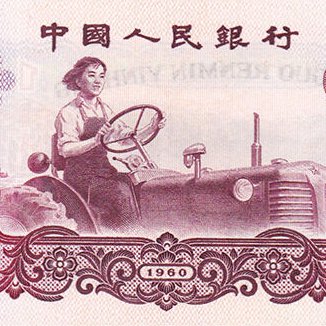Karl Gerth, University of California, San Diego
Summary
Wristwatches were one of the most desired mass-produced industrial products in the Mao era, 1949-76. They began the era as imported luxury items owned only by the wealthy. But they ended the era domestically mass-produced by the millions. On the one hand, they were a symbol of the successful efforts to build Chinese industry, science, and technology. On the other, only a small fraction of a population of some 700 million managed to obtain one. The distribution of these watches was a consequence of a specific economic policy. Sometimes, the state used propaganda to promote watch consumption, such as movies made by the state featuring watches. Other times, the state discouraged any form of consumerism, especially after the start of the Cultural Revolution in 1966. Wristwatches were an everyday symbol of the inequality that the Communist Revolution of 1949 had intended to end but that accompanied industrialization.The Introduction and Spread of Wristwatches
What did people in the Mao era (1949-76) want to acquire? And what can those material desires tell us about the era? Beyond the basic necessities, the most desired things in cities, towns, and a growing number of villages around the country was what were known as the 'Three Great Things' (san da jian 三大件). The exact three varied by time and place but most often included a wristwatch, bicycle, and sewing machine. Throughout the 1940s, all three were expensive, hard to acquire, usually manufactured by foreign-owned companies or imported, and only found in the homes of the wealthy. After the establishment of the People’s Republic of China (PRC) in 1949, domestic industry quickly recovered from decades of war. Still, having any one of the 'Three Great Things' was rare. The situation changed fast. Policies of the Chinese Communist Party (CCP) made the Three Greats increasingly available to more people in cities, towns, and even parts of the countryside. By the end of the 1970s, they had become so commonplace that the original 'Three Greats' were no longer considered luxuries.
The history of wristwatches, one of the 'Three Greats', reveals the spread of consumerism in the Mao era. And examining the spread of consumerism has implications for how we interpret the era. Despite years of mass campaigns and CCP socialist rhetoric vilifying 'bourgeois' material desire and promoting an ethos of 'hard work and simple living' as the foundation of socialism, popular demand for everyday technologies such as wristwatches spread into new classes and places across China. Watches became so fashionable in the 1960s and 1970s that children painted them onto their wrists or received toy versions as a gift as a substitute for a real watch [see ⧉source: Newspaper article on children’s toys].1
The spread of desire for wristwatches reveals all three aspects that define the term consumerism here. First, by the end of the 1950s, the PRC had begun to mass-produce a growing number and range of wristwatches [see ⧉source: Chart of expanding brands and varieties of wristwatches]. Second, the PRC mass-produced discourse about products. The era witnessed the dissemination of knowledge about wristwatches—what they were and why they might be useful. And, third, as with all the other newly available mass-produced products, wristwatches became a means to create and communicate identities. A Shanghai brand wristwatch, for instance, became more fashionable than a lesser-known regional or local brand such as Nanjing’s Zhongshan brand watch (Zhongshan 钟山) but not as good as an Enicar (Yingge 英格) or Roamer (Luoma 罗马), two imported Swiss brands.2 In short, the growing numbers and varieties of wristwatches manifest spreading consumerism.
Domestic Production of Wristwatches
The CCP prioritized some consumer products more than others. Perfume and cosmetics became hard to find. Although watches were relatively unimportant in agricultural societies, where the sun provided a natural clock, they were critical tools in industrializing countries such as China. Countless aspects of industrialization required accurate time-keeping. Consequently, a growing number of people felt the need to acquire a watch. Workers in factories and offices, for instance, relied on timepieces to coordinate labor shifts and schedules also used—and felt compelled to acquire—watches to counter management control over time. In addition to the centrality of keeping time in factories, railroad workers needed to adhere to accurate schedules, especially when trains going in the opposite directions shared the same tracks. Likewise, military men needed synchronization for military maneuvers.
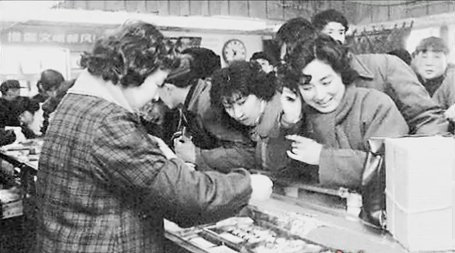
Despite the growing need for watches, the PRC initially lacked the capacity to manufacture wristwatches. With over a hundred parts and over a hundred procedures to assemble, watch production was technically complicated. For nearly a decade after 1949, China had to rely on imported watches. Switzerland continued to supply most imported watches (80%). China also imported Soviet, French, Japanese, and German watches. Imports in the 1950s fluctuated from a low of 36,000 in 1954 to a high of 1,341,000 in 1956. Even after annual domestic production surpassed a million watches in 1965, the supply was never enough to meet demand, and China still imported millions more [see source: Consumer frenzy to buy a Shanghai watch, also depicted to the left].
But as early as 1955, the CCP mobilized state resources to overcome the technological hurdles of manufacturing its own wristwatches. Key to this effort were the country’s many experienced watch repairers, who were accustomed to working on watches from around the world and provided engineers with knowledge about many different kinds of watches and a chance to experiment on them. Of a hundred trial watches assembled in this effort, only a dozen or so actually worked. Finally, by using a Swiss-made Selca (Saierka 塞尔卡) watch as a reference, technicians were able to produce a working model. While the resulting watches were not completely 'Chinese', as they relied on imported Soviet and Japanese components, they represented a major step toward accomplishing the CCP’s goal of domestic wristwatch production.
The CCP officially established a state factory to mass produce the watch in 1958, and the new watches entered consumer markets that year under the brand name Shanghai.3 Production began slowly, with just 16,800 watches manufactured in 1958. But, in 1958 and 1959, the state set up additional factories in Beijing, Guangzhou, Jilin, and Dandong. Other brands soon followed, including Forward (Qianjin 前进) in 1960, built on a Soviet model (and probably Soviet machines), and a Red Flag (Hongqi 红旗) brand in 1966 that used Swiss equipment. Domestic production ramped up dramatically in the 1960s. By 1965, China was manufacturing more than one million watches per year. And production continued to expand, even during the height of the Cultural Revolution in the late 1960s, and surpassed 13 million by 1978.4
Unequal Distribution
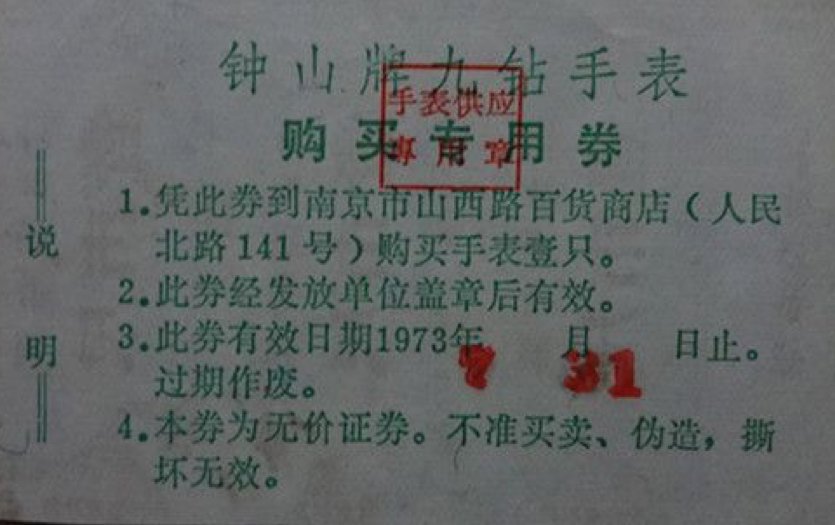
Despite the impressive growth in domestic production, the totals represented only a tiny fraction of the population of 700 million potential watch buyers.5 Consequently, watches initially became a widespread marker of inequality, another hallmark of consumerism. Watch ownership did not proliferate uniformly. At first, to obtain a wristwatch one needed an official government ration or the money to get one through illicit sources such as smuggling [see ⧉source: Wristwatch paperwork, including the image depicted to the right]. Later, other less expensive and less desirable brands came onto the market. People learned to differentiate the various brands as better and worse, fashionable and unfashionable through these differences. A factory manager in Shanghai—where there were at least ninety well-known product brands by the end of the Mao era—would have had a different experience with consumerism. That manager would have, for instance, had greater knowledge of and desire for an Enicar than, say, a farmer in rural Guangxi Province [see source: Mr. Chen acquires a wristwatch].6
But knowledge and desire for wristwatches spread faster and further than their acquisition. Even a very poor person with little chance of acquiring a wristwatch might have learned to desire a watch by seeing them on street advertisements, observing them on actors in a state-made movie projected by a traveling film team visiting their isolated village, an urbanite relocated to the countryside [see ⧉source: Wristwatches in film 'Nurse's Diary'], in countless other ways. As a child viewing a propaganda film, for instance, Zhang Huihu 张辉虎 learned that the villain was identifiable because he wore six watches on his wrists, which, as Zhang’s father explained, indicated the man was corrupt. But young Zhang also learned from the film that the Shanghai brand wristwatch was the most desirable. So, he harboured a desire for one for decades before acquiring one.7
Everyday life pushed people to desire wristwatches for innumerable social uses, including as bribes to officials, wedding gifts, ways for farmers to store value after a good harvest, and enticements offered by parents to get their children to study harder for school entrance exams. These social uses proliferated so fast and became so important that, arguably, the acquisition of a wristwatch became increasingly compulsory. Perhaps the most important function of the 'Three Greats' came for a family wanting to marry off its young men to suitable women. A bride’s family expected even modestly well-off young men’s families to provide at least one and ideally all 'Three Greats' at the time of betrothal. Failure to do so suggested that the groom was not a desirable match. This expectation was so deep-seated in cities and villages that in some cases, a man’s family would borrow money to obtain the necessary items and pay off the debt after the marriage.8
Consumerism was becoming embedded in the era, with products communicating new and different messages depending on the owner and context. When eighteen-year old Li Dong 李动 joined the Air Force as a mechanic for the J-6 fighter jet, for instance, he and others from Shanghai were proud of the possessions they brought to the base with them, including soaps to wash uniforms, better blankets, and scented skin lotions (which they put under their noses when going to the latrine to mask the smell). Because the soldiers from villages and towns either lacked or did not use any of these products their presence soon grabbed attention. Although to these young men their nicer possessions communicated urbane identities and superior educations, they drew criticism from superior officers who invoked the oft-promoted 'socialist' ethos of hard work and simple living and considered their nice shirts and wristwatches bourgeois extravagances. His superior officer informed him that if he continued to display these goods, he would not be allowed to join the Communist Party, which was the goal of every upwardly mobile soldier. Thereafter, Li never showed his watch to anyone and kept it in his pocket to consult on the sly.9
The growing desire for products such as wristwatches to communicate and reinforce social differences reveals a central contradiction of the Mao era. On the one hand, wristwatch production symbolized national industrial success in general and CCP economic policy success in particular, just as their absence had done the opposite. Under the CCP, the PRC accumulated the human and industrial capacities to mass produce wristwatches and many other everyday technologies. The CCP policies promoting production had helped turn luxuries associated with imperialist powers and found primarily in urban elites into things new classes of people across China could realistically aspire to acquire. But, on the other hand, as products such as wristwatches became part of everyday life, they introduced or reinforced the inequalities and social hierarchies directly at odds with the CCP’s rhetoric of socialism: urban, managers, working in factories received more of the total economic output of society than rural, female farmers. Indeed, the CCP even used state power to extract the agricultural surplus from the countryside to further subsidize urban-based industrialization. In short, under the banner of socialism, the CCP accelerated the development of inequality, not its elimination.
The Link between Brands and Consumerism
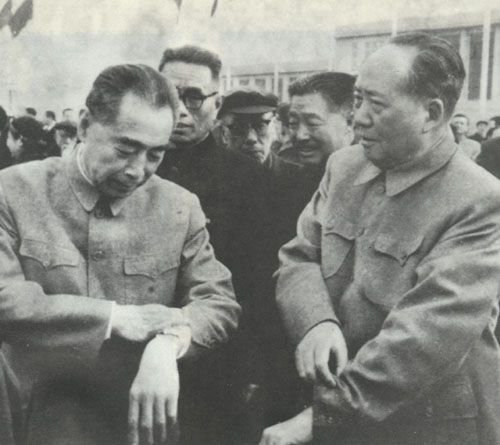
Another aspect of consumerism, variety within product categories, compounded the basic inequality of distribution. Conspicuous consumption in the Mao era included a hierarchy of branded consumer products that people used to communicate social difference and status [see ⧉source: Mao and Zhou Enlai set their watches at Beijing Airport, also depicted to the left]. The introduction of domestically manufactured watches in the 1950s and 1960s complicated the hierarchy of prestige and quality. Swiss watches remained firmly at the top of the brand hierarchy, where they had been since before 1949. But once China-made watches were introduced in the late 1950s, they quickly became the two second most prestigious brands, particularly the brands associated with the leading centers of consumerism in China, Shanghai brand (Shanghai 上海牌), and Tianjin’s Seagull brand (Haiou 海鸥牌). Japanese watches, particularly Seiko (Jinggongshe 精工舍) and Citizen (Xitiecheng 西铁城) remained prestigious, though tended to be used. Even at the height of Sino-Soviet Friendship in the 1950s, Soviet watches were at the bottom of the pecking order. As one resident of Nanjing put it, they were 'good for using, not for showing off.'10 In addition, watch manufacturers produced different designs to allow people to express different tastes [See ⧉source: Shanghai brand logo designs].
Consumerism teaches people to want more. In an equivalent to the 'keeping up with the Joneses,' it was not always good enough to simply have one or all of the 'Three Greats'. Some differentiated themselves by acquiring first the knowledge of and then possession of the most fashionable brands. Such awareness of distinctions and the desire itself reproduced a core principle of consumerism. At first, Chen Yilin 陈毅林, for instance, was the proud owner of a regional brand, the Yangcheng (羊城), made in Guangzhou. His colleagues envied his watch. But as they themselves not only obtained watches but also obtained the more fashionable Shanghai brand, he began to feel self-conscious, especially after a colleague told him point blank: 'nobody wears a Yangcheng anymore.' He soon switched to a Shanghai and remained brand-conscious. As Japanese Citizen watches returned to the Chinese marketplace at the end of the 1970s, he was among the first to acquire this latest and most fashionable brand.11 [See ⧉source: Chen Yilin remembers his watches]
Conclusion
The expanding desire for wristwatches reveals many things about the Mao era. Clearly, the Mao era had consumerism. Mass production of wristwatches expanded across the era, spreading knowledge and desire for wristwatches, including for specific brands, into homes around the country. These wristwatches, however, were not distributed by the CCP to everyone at once. Instead, the distribution of wristwatches underscored a central contradiction of the Mao era. On the one hand, they symbolized national industrial success. The PRC began to make good watches. But, on the other hand, wristwatches introduced or reinforced the inequalities and social hierarchies directly at odds with the CCP’s rhetoric of socialism. This leaves open the question: what sort of 'socialism' did the CCP create alongside consumerism?
Footnotes
Xia Huiheng 夏惠恒, 'How to buy toys for kids' (zenyang gei xiaohai mai wanju 怎样给小孩买玩具), Hangzhou Ribao (20 January 1959).
Xie Chunchi 谢春池, I know, I am forever an Educated Youth (wo zhidao, wo shi yi ge yongyuan de zhiqing 我知道, 我是一个永远的知青) (Beijing: Zhongguo wenlian chubanshe, 1998), 82-83.
Shen Jialu 沈嘉禄, 'A581: The progenitor of China-made watches' (A581: zhongguo shoubiao de shizu A581: 中国手表的始祖), Sina Blog (Archived in Wayback Machine on 12 November 2017). The first model was the A581, with the '58' representing the first year of its manufacture and the '1' signifying that it was the first model.
For yearly wristwatch production and imports, see Shangye bu baihuo ju (商业部百货局编) (ed.), A history of Chinese general commerce (Zhongguo baihuo shangye 中国百货商业) (Beijing: Beijing daxue chubanshe, 1989), 175.
Ibid., 169.
Zhu Zhanliang 朱展良, 'A brief analysis of famous brands produced by Shanghai light industry' (Shanghai qinggongye mingpai chanpin chutan 上海轻工业名牌产品初探), Shanghai jingji yanjiu (上海经济研究), No.9 (1981): 7-11.
Zhang Huihu 张辉虎, 'The bad guy with six watches on his wrists' (dai liu kuai biao de huairen 戴六块表的坏人) in Wang Xiaozhen 王晓真, ed., Stories of merchandise (shangpin de gushi 商品的故事) (Guangdong: Guangdong Nanfang ribao chubanshe, 2000), 40-41.
Diamant, Neil J., Revolutionizing the Family: Politics, Love, and Divorce in Urban and Rural China, 1949-1968 (Oakland, CA: University of California Press, 2000), 260.
Li Dong 李动, 'The eternal J-6' (yongyuan de jian 6 永远的歼6) in Shanghai Local Chronicle Office (Shanghai difangzhi banggongshi 上海地方志办公室), ed. Shanghai soldiers in the People’s Army (Renmin jundui zhong de shanghaibing 人民军队中的上海兵) (Shanghai: Shanghai Renmin chubanshe, 2013), 349.
Lü Huwei (pseudonym) 履虎尾, 'The Story of the Wristwratch (3)' (shoubiao de gushi (san) zaichang 手表的故事(三)再唱) 2 November 2007, Sina Blog (Archived in Wayback Machine on 7 January 2019), accessed 21 September 2010; Shi Shenglin 时盛麟, 'The Soviet' (Sulian dahuabuheshoubiao 苏联大花布和手表) 29 July 2010, Sina Blog (https://web.archive.org/web/20171107230227/http://blog.sina.com.cn/s/blog_65d891800102e53r.html) archived 7 November 2017.
Chen Yilin 陈毅林, 'Three watches' (san kuai shoubiao 三块手表), Wenshi yuekan (文史月刊), Iss. 12 (December 2008): 68.
Sources
- ⧉ IMAGE
- 文 TEXT
- ▸ VIDEO
- ♪ AUDIO
- ⧉Image Wristwatches: Children's Toys
- ⧉Image Wristwatches: Proliferation Of China-made Watches
- ⧉Image Wristwatches: Consumer Frenzy To Buy Domestic Watches
- ⧉Image Wristwatch Paperwork
- ⧉Image Wristwatches: Mr. Chen Acquires A Wristwatch
- ⧉Image Wristwatches In Film 'Nurse's Diary'
- ⧉Image Wristwatches: Mao And Zhou At Beijing Airport
- ⧉Image Wristwatches: Shanghai Brand Logo Designs
- ▤Pdf Wristwatches: Chen Yilin Remembers His Watches
Further Reading
Diamant, Neil J. Revolutionizing the Family: Politics, Love, and Divorce In Urban and Rural China, 1949-1968. Oakland, CA: University of California Press, 2000.
Gerth, Karl. 'Compromising with Consumerism in Socialist China: Transnational Flows and Internal Tensions in "Socialist Advertising,"' Past & Present vol. 218 (Spring 2013): 203-232.
Gerth, Karl. Unending Capitalism: Consumerism and the Negation of the Chinese Socialist Revolution. Cambridge: Cambridge University Press, forthcoming.
Landes, David S. Revolution in Time: Clocks and the Making of the Modern World. Cambridge: Belknap Press of Harvard University Press, 1983.
